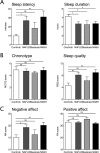Sleep Disruption and Daytime Sleepiness Correlating with Disease Severity and Insulin Resistance in Non-Alcoholic Fatty Liver Disease: A Comparison with Healthy Controls
- PMID: 26576055
- PMCID: PMC4648512
- DOI: 10.1371/journal.pone.0143293
Sleep Disruption and Daytime Sleepiness Correlating with Disease Severity and Insulin Resistance in Non-Alcoholic Fatty Liver Disease: A Comparison with Healthy Controls
Abstract
Background & aims: Sleep disturbance is associated with the development of obesity, diabetes and hepatic steatosis in murine models. Hepatic triglyceride accumulation oscillates in a circadian rhythm regulated by clock genes, light-dark cycle and feeding time in mice. The role of the sleep-wake cycle in the pathogenesis of human non-alcoholic fatty liver disease (NAFLD) is indeterminate. We sought to detail sleep characteristics, daytime sleepiness and meal times in relation to disease severity in patients with NAFLD.
Methods: Basic Sleep duration and latency, daytime sleepiness (Epworth sleepiness scale), Pittsburgh sleep quality index, positive and negative affect scale, Munich Chronotype Questionnaire and an eating habit questionnaire were assessed in 46 patients with biopsy-proven NAFLD and 22 healthy controls, and correlated with biochemical and histological parameters.
Results: In NAFLD compared to healthy controls, time to fall asleep was vastly prolonged (26.9 vs. 9.8 min., p = 0.0176) and sleep duration was shortened (6.3 vs. 7.2 hours, p = 0.0149). Sleep quality was poor (Pittsburgh sleep quality index 8.2 vs. 4.7, p = 0.0074) and correlated with changes in affect. Meal frequency was shifted towards night-times (p = 0.001). In NAFLD but not controls, daytime sleepiness significantly correlated with liver enzymes (ALAT [r = 0.44, p = 0.0029], ASAT [r = 0.46, p = 0.0017]) and insulin resistance (HOMA-IR [r = 0.5, p = 0.0009]) independent of cirrhosis. In patients with fibrosis, daytime sleepiness correlated with the degree of fibrosis (r = 0.364, p = 0.019).
Conclusions: In NAFLD sleep duration was shortened, sleep onset was delayed and sleep quality poor. Food-intake was shifted towards the night. Daytime sleepiness was positively linked to biochemical and histologic surrogates of disease severity. The data may indicate a role for sleep-wake cycle regulation and timing of food-intake in the pathogenesis of human NAFLD as suggested from murine models.
Conflict of interest statement
Figures




References
-
- Speliotes EK, Yerges-Armstrong LM, Wu J, Hernaez R, Kim LJ, Palmer CD, et al. Genome-wide association analysis identifies variants associated with nonalcoholic fatty liver disease that have distinct effects on metabolic traits. PLoS Genet. 2011;7: e1001324 10.1371/journal.pgen.1001324 - DOI - PMC - PubMed
Publication types
MeSH terms
LinkOut - more resources
Full Text Sources
Other Literature Sources
Medical

